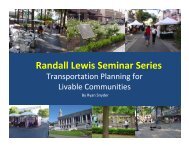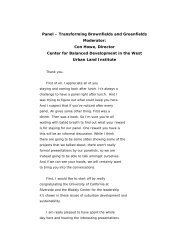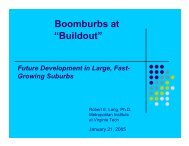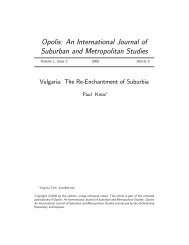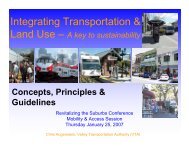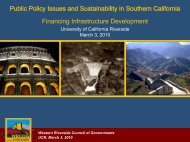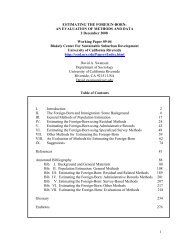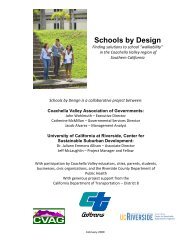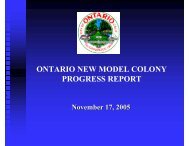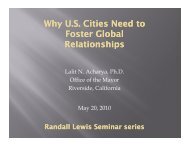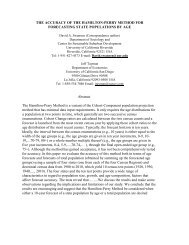Latino New Urbanism: Building on Cultural Preferences - Center for ...
Latino New Urbanism: Building on Cultural Preferences - Center for ...
Latino New Urbanism: Building on Cultural Preferences - Center for ...
You also want an ePaper? Increase the reach of your titles
YUMPU automatically turns print PDFs into web optimized ePapers that Google loves.
from multiple cultures, n<strong>on</strong>-<str<strong>on</strong>g>Latino</str<strong>on</strong>g>s will<br />
need to adopt a porti<strong>on</strong> of the compact<br />
lifestyle of <str<strong>on</strong>g>Latino</str<strong>on</strong>g>s. What is required,<br />
in essence, is a redefiniti<strong>on</strong> of what<br />
c<strong>on</strong>stitutes the desired middle-class<br />
lifestyle in Cali<strong>for</strong>nia, so that when<br />
immigrants assimilate they have<br />
models other than suburban sprawl<br />
(Myers 2001).<br />
The development of compact<br />
communities <strong>for</strong> middle-class n<strong>on</strong>-<br />
<str<strong>on</strong>g>Latino</str<strong>on</strong>g>s must first overcome<br />
governmental regulati<strong>on</strong>s and<br />
percepti<strong>on</strong>s that dense residential<br />
communities are associated with lower<br />
incomes, noise, and crime. This can<br />
be partly achieved through more<br />
fashi<strong>on</strong>able and innovative designs.<br />
The next secti<strong>on</strong> assesses the current<br />
preferences of Cali<strong>for</strong>nians and<br />
evaluates whether there is a significant<br />
demand <strong>for</strong> establishing compact<br />
developments.<br />
Cali<strong>for</strong>nian and <str<strong>on</strong>g>Latino</str<strong>on</strong>g> <strong>Preferences</strong> <strong>for</strong><br />
Compact Cities<br />
The survey results presented here<br />
gauge the current opportunity to build<br />
compact cities, highlighting the<br />
attitudes am<strong>on</strong>g the general Cali<strong>for</strong>nia<br />
populati<strong>on</strong> and <str<strong>on</strong>g>Latino</str<strong>on</strong>g>s. The survey<br />
data assesses Cali<strong>for</strong>nia residents’<br />
attitudes toward c<strong>on</strong>venti<strong>on</strong>al norms<br />
<strong>for</strong> land use and suburban<br />
development in the state. C<strong>on</strong>venti<strong>on</strong>al<br />
thought dictates that most c<strong>on</strong>sumers<br />
prefer low-density, single-family<br />
housing. However, the survey results<br />
show that the public’s views <strong>on</strong> housing<br />
and land use often c<strong>on</strong>flict and do not<br />
reflect the various trade-offs<br />
encountered over a lifetime.<br />
Mendez: <str<strong>on</strong>g>Latino</str<strong>on</strong>g> <str<strong>on</strong>g>New</str<strong>on</strong>g> <str<strong>on</strong>g>Urbanism</str<strong>on</strong>g><br />
41<br />
Cali<strong>for</strong>nia/<str<strong>on</strong>g>Latino</str<strong>on</strong>g> Mixed-Use and<br />
Higher Densities<br />
The Public Policy Institute of<br />
Cali<strong>for</strong>nia’s (PPIC) 2002 survey of<br />
2,010 adult Cali<strong>for</strong>nia residents <strong>on</strong><br />
“Growth, Land Use, and the<br />
Envir<strong>on</strong>ment” supported c<strong>on</strong>venti<strong>on</strong>al<br />
thought and showed that the majority<br />
of Cali<strong>for</strong>nia residents have str<strong>on</strong>g<br />
preferences <strong>for</strong> dispersed, suburban<br />
development. Sixty-five percent of<br />
Cali<strong>for</strong>nians want to live in a singlefamily<br />
detached home. However, the<br />
same data also underlines a significant<br />
demand <strong>for</strong> alternative housing types<br />
under certain circumstances.<br />
Nearly half of all resp<strong>on</strong>dents said they<br />
would prefer a smaller house if it meant<br />
having a short commute. Similarly, 46<br />
percent of <str<strong>on</strong>g>Latino</str<strong>on</strong>g> resp<strong>on</strong>dents said<br />
they prefer a smaller house and shorter<br />
commute. Fifty percent of Cali<strong>for</strong>nia<br />
resp<strong>on</strong>dents said they would rather live<br />
in a residential-<strong>on</strong>ly neighborhood and<br />
drive to stores and services, versus 47<br />
percent who said they would choose<br />
to live in a mixed-use neighborhood<br />
where local amenities were within<br />
walking distance. <str<strong>on</strong>g>Latino</str<strong>on</strong>g>s were more<br />
likely to prefer a mixed-use<br />
neighborhood (52 percent to 46<br />
percent) than n<strong>on</strong>-Hispanic whites.<br />
Additi<strong>on</strong>ally, <str<strong>on</strong>g>Latino</str<strong>on</strong>g>s were more willing<br />
to choose high-density neighborhoods<br />
with public transit than n<strong>on</strong>-Hispanic<br />
whites, 39 percent to 24 percent<br />
respectively. Nevertheless, both<br />
groups str<strong>on</strong>gly favored low-density<br />
neighborhoods over any other type (59<br />
percent <strong>for</strong> <str<strong>on</strong>g>Latino</str<strong>on</strong>g>s and 72 percent <strong>for</strong><br />
whites).



